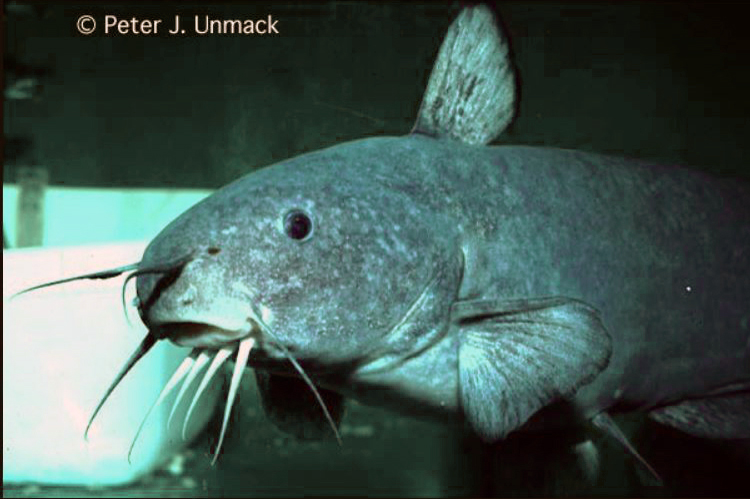- Classification
- ACTINOPTERYGII
- SILURIFORMES
- PLOTOSIDAE
- Neosiluroides
- cooperensis
Cooper Creek Catfish, Neosiluroides cooperensis Allen & Feinberg 1998

A female Cooper Creek Catfish, Neosiluroides cooperensis, from the Thompson River, Longreach, Queensland, 48 cm TL. Source: Peter Unmack, Desert Fishes Council. License: All rights reserved
Cooper Creek Catfish, Neosiluroides cooperensis Allen & Feinberg 1998
More Info
|
Distribution |
Known only from the Cooper Creek system of south-west Queensland and north-east South Australia, in the Lake Eyre Basin drainage. Inhabits larger permanent waterholes of intermittent streams, usually with muddy substrates and very turbid water. |
|
Features |
First dorsal fin I, 4-5; CDA 108-132; Pectoral fin I, 11-13; Pelvic fin 11-13; Gill rakers (first arch) 5-8 + 15-18; Vertebrae 63-67.
Body elongate, slender, laterally compressed and tapering posteriorly; head robust, moderately flattened dorsoventrally; head length 18-23% SL; snout rounded in lateral view; mouth subterminal; lips fleshy; anterior nostril tubular, on upper lip; posterior nostril directly behind nasal barbel, sheathed in thick epidermal layer forming an additional outer chamber with a fimbrate external opening; eyes relatively small (12% HL); 4 pairs of nasal barbels; nasal barbel reaching well past eye level; maxillary barbel reaching eye; outer mental barbel reaching gill opening, inner mental barbel slightly shorter; teeth slender, conical in several rows on upper and lower jaws, with patch of molariform teeth covering most of palate. Scales absent; skin densely covered in minute papillae. Dorsal fin relatively short, pointed, originating in front of level of ventral fin by a head width; pectoral fins inserted just behind opercular margin; tips of pectoral fins pointed to slightly rounded; anterior edges of dorsal and pectoral fin spines weakly serrate; caudo-dorsal fin originating far back near end of body, base 11-16% SL. |
|
Size |
To 46 cm TL |
|
Colour |
Pale grey to creamy brown dorsally, usually with dark speckling, sometimes mottled on sides, becoming whitish below; fins often yellowish. |
|
Feeding |
Feeds on gastropods and crustaceans. |
|
Biology |
Little is known of the reproductive biology of this species. Eggs are large (3-4 mm) and fecundity low (1000 eggs per spawning). |
|
Similar Species |
Differs from all other Australian plotosids by its unusual rear nostril which is sheathed in a thick layer of skin forming an additional outer chamber; also skin covered in tiny papillae. |
|
Etymology |
The generic name Neosiluroides refers to the superficial resemblance to the genus Neosilurus. The species is named cooperensis in reference to its known distribution which is confined to Cooper Creek and its tributaries. |
|
Species Citation |
Neosiluroides cooperensis Allen & Feinberg 1998, Aqua, J. Ichthyol. Aquat. Biol 3(1): 12, fig. 2. Type locality: Callamurra Waterhole, Cooper’s Creek, 11.3 km east of Innamincka, South Australia [27°41’S, 140°51’E]. |
|
Author |
Gomon, M.F. & Bray, D.J. 2018 |
|
Resources |
Cooper Creek Catfish, Neosiluroides cooperensis Allen & Feinberg 1998
References
Allen, G.R. & Feinberg, M.N. 1998. Descriptions of a new genus and four new species of freshwater catfishes (Plotosidae) from Australia. Aqua, Journal of Ichthyology and Aquatic Biology 3(1): 9-18 figs 1-6
Allen, G.R., Midgley, S.H. & Allen, M. 2002. Field Guide to the Freshwater Fishes of Australia. Perth : Western Australian Museum 394 pp.
Ferraris, C.J. 2007. Checklist of catfishes, recent and fossil (Osteichthyes: Siluriformes), and catalogue of siluriform primary types. Zootaxa 1418: 1–628
Hammer, M.P. & Walker, K.F. 2004. A catalogue of South Australian freshwater fishes, including new records, range extensions and translocations. Transactions of the Royal Society of South Australia 128(2): 85-97
Unmack, P.J. 2001. Biogeography of Australian freshwater fishes. Journal of Biogeography 28: 1053-1089
Wager, R. & Unmack, P.J. 2000. Fishes of the Lake Eyre Catchment of Central Australia. Brisbane : Department of Primary Industries and Queensland Fisheries Service 88 pp.



